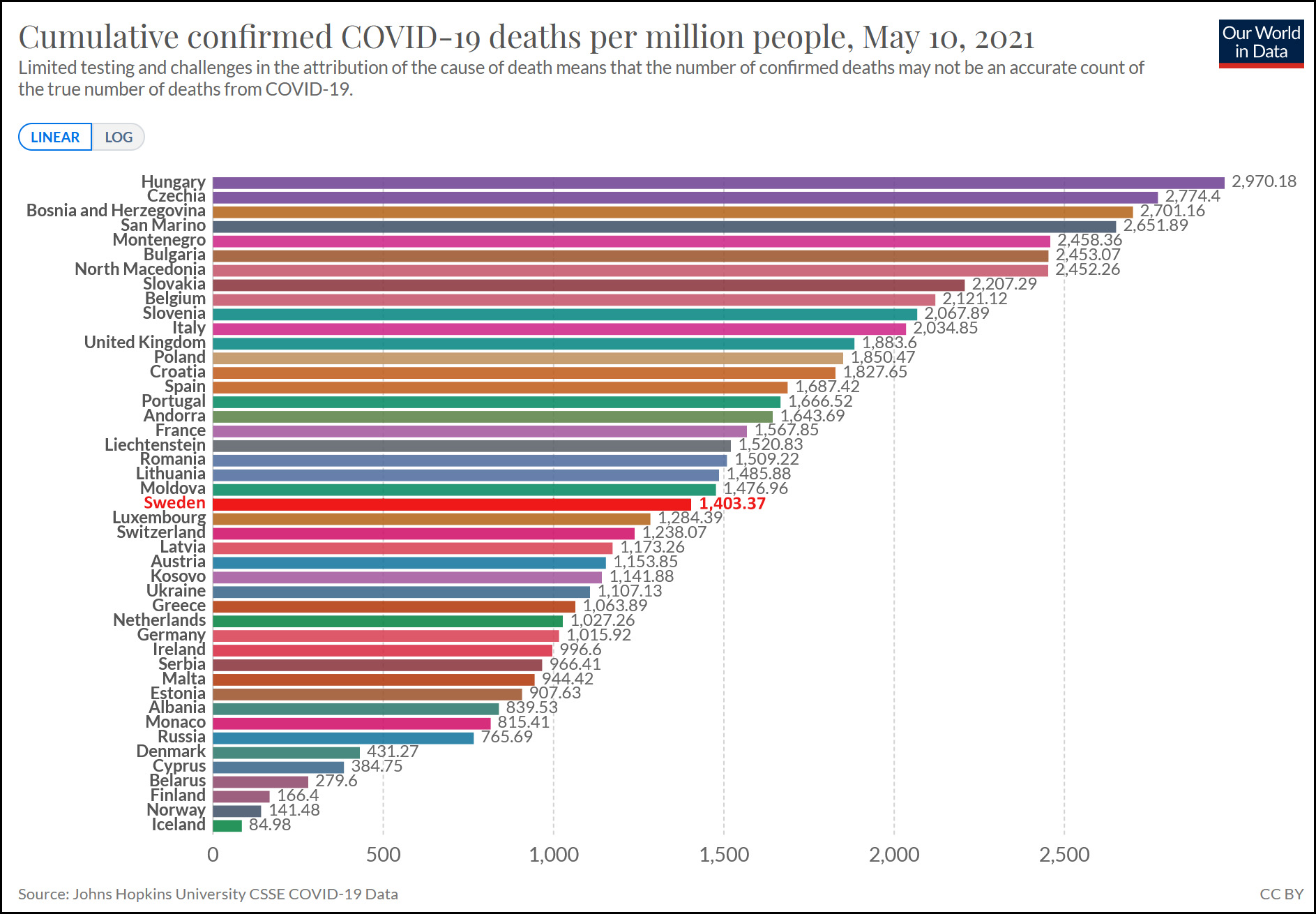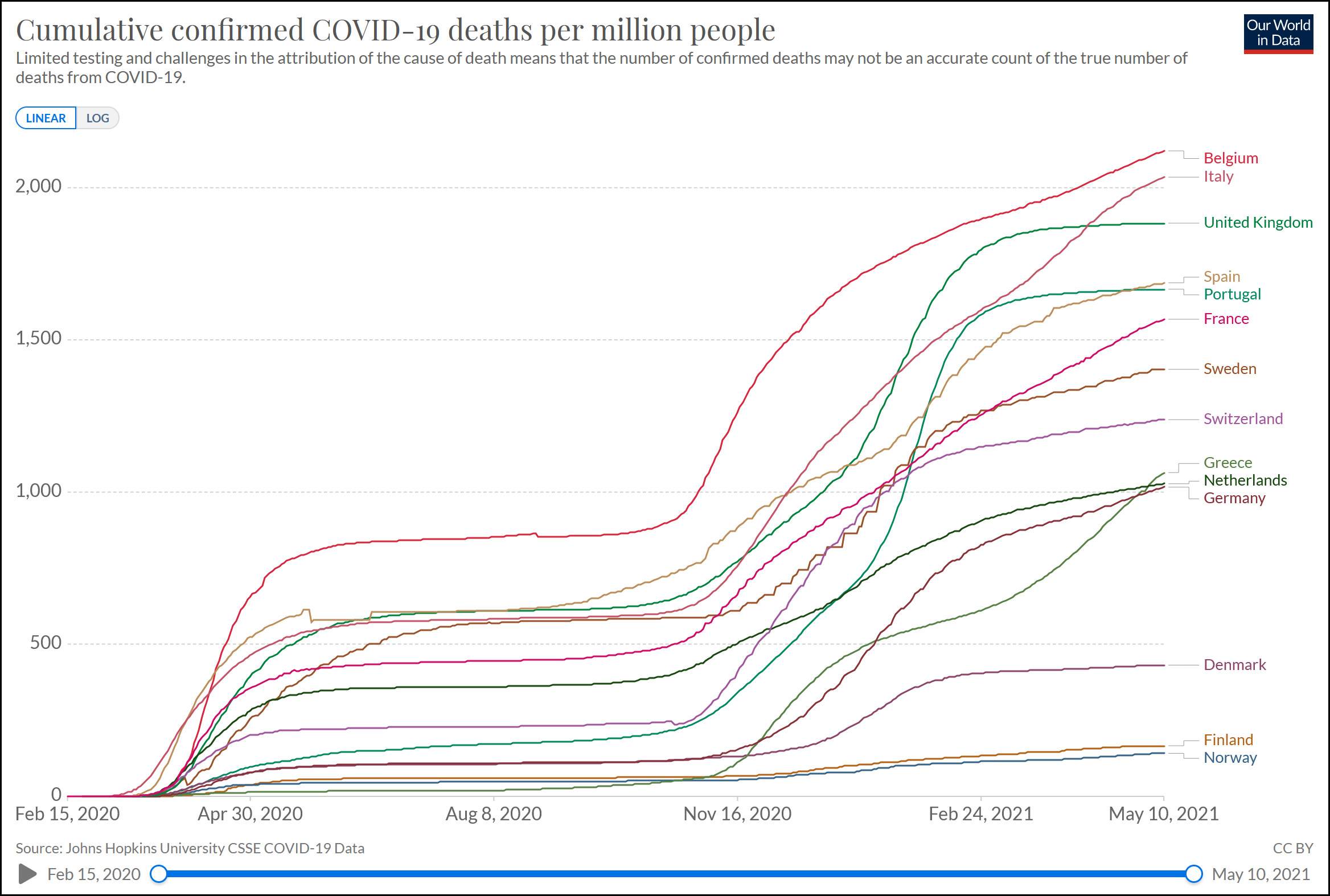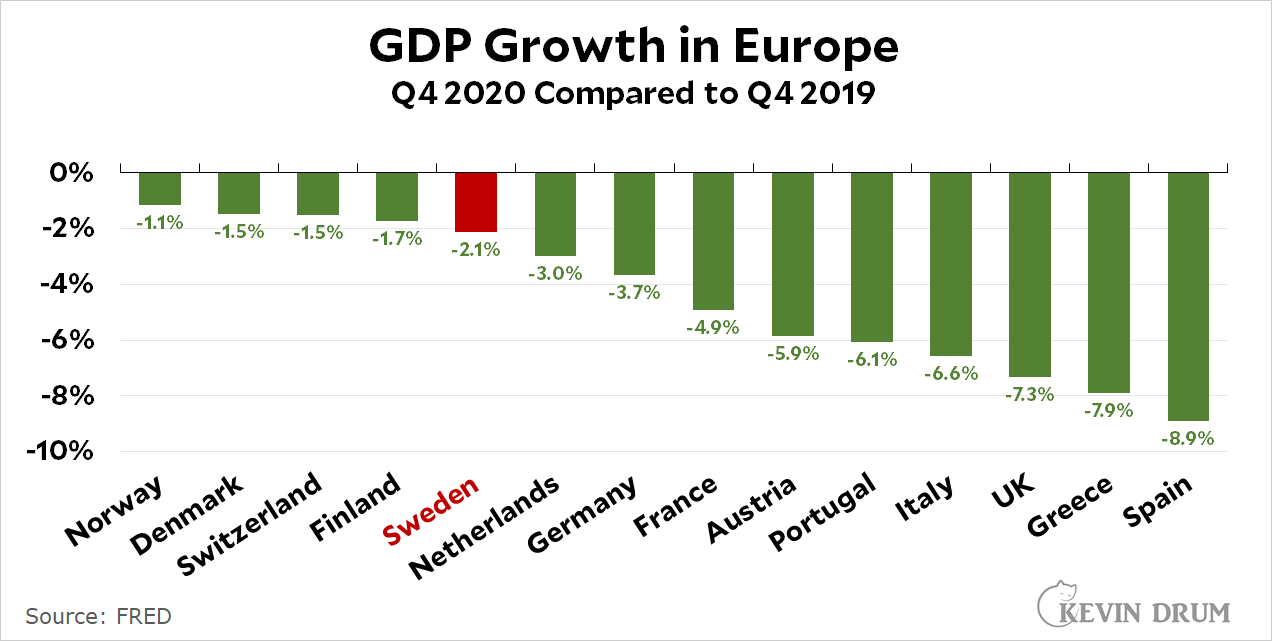Tim Skellet reminds me to do a final postmortem on the Swedish pandemic experiment. As you'll recall, they basically went about business as usual on the premise that the coronavirus would do what it was going to do regardless of what measures they took. So how did that work out?
One thing that's universally agreed on is that they did a terrible job with the elderly. Their death rate in nursing homes was quite high, and they plainly could have done more to stop it.
More broadly, though, here's how their death rate compares with every other country in Europe:

Here's a look at COVID-19 deaths over time:

In both cases, Sweden is about in the middle. As usual, though, their performance depends on who you're comparing them to. Compared to the rest of Europe, they're so-so. Compared to other Nordic countries, their mortality rate per million is terrible:
- Sweden: 1,403
- Denmark: 431
- Norway: 141
- Finland: 166
Did any of this pay off in better economic performance compared to the rest of Europe?

Again, it depends on who you're comparing to. Sweden did pretty well compared to other European countries in general, but not as well as the other Nordic countries.
So I'm honestly not sure how to judge Sweden. If you compare them to other Nordic countries, which all took more aggressive countermeasures, their death rate is higher and their economic performance is worse.
But if you compare them to all the other countries of Europe, which also took more aggressive countermeasures, their death rate is lower and their economic performance is better.
It all boils down to whether there's something special about Nordic countries that makes them a proper unit of comparison. I don't have an answer to that, so perhaps this isn't really the final postmortem after all?

Well, think like an epidemiologist, or perhaps a virus. Viruses spread from person to person: more people packed tighter together means more spread. Comparing to, say, Belgium -- by far the most crowded non-miniature country in Europe -- would be inappropriate. Scandinavian countries, except for Denmark, generally have the lowest densities in Europe, so they're probably not a bad comparison group, plus they have the additional "control" of being culturally similar.
Sweden is close to Norway in population density, but Sweden has a more urbanized population, as well as a slightly higher overall density, so one might expect Sweden to be slightly worse, but the actual difference is really high. Ditto Finland. And in comparison to Denmark, Sweden looks really bad, because Denmark is much more crowded.
Otherwise, Spain-Portugal-France-Greece are in roughly the same density band, which is a good 4-6 times as high as Sweden, so again Sweden doesn't look so good. And Switzerland-Germany are like 9-10 times as dense, so Sweden looks outright bad.
Sorry, Belgium AND the Netherlands are the most crowded, although IIRC Belgium is more urbanized.
It's all the Euro-folk and the NATO-tribe spreading their filthy germs.
I'm curious why you never refer to the number of infections.
One thing we've learned is that long-COVID affects quite a few people and it could be quite insidious from breaking the blood-brain barrier. Also, if immunologists are to be believed, the more infections there are, the more likely variants will accumulate and build additional mutations on top of existing ones.
Right now, only a couple other European countries are doing worse than Sweden, in # of infections per 100K -- they're averaging ~47 infections per 100K.
If India had Sweden's *current* infection rate, they'd have 640K infections today. Doesn't that shake your confidence in Sweden's approach at all?
As I understand it, at least early on, Sweden wasn’t doing a really good job in testing. India is likely the same. But I agree that the number of people getting the disease is an important metric that doesn’t get the attention it should.
If I remember the jibbering and the jabbering in the beginning over on MJ, the Chart Maker was attempting to rectify the poor reporting, the underreporting, the overpowering, the no reporting, and decided to stick to just deaths. Besides, rick does a good job of you want data the hard way...
Well my limited take is this: my sister-in-law is married to a Swede. He is one of the most buttoned down rule following types I've ever met in my life. When they lived in Sweden she's write my wife (pre-email days) and complain about how uptight the people there were. So I would guess the people were probably doing more about following guidelines than in other places.
My extended family on the other hand is in Italy. These people have never met a rule they didn't try to break or a corner they didn't cut. It's almost like sport, seeing how much you can get away with. Thankfully none of them died though a few did get quite sick. My mother was on Facebook everyday checking in on them. And they were doing stupid shit like visiting friends during the height of lockdown and meeting in groups to walk one person's dog.
You nailed it. This is why Scandinavian countries did almost as well as East-Asian ones: they're conformist too. Holland and Germany, also very consensual countries despite their politics (and I originally hail from Holland, and don't like my own motherland because of it), of course also do better than southern countries.
Being a Swede myself, I can definitely verify this about the Swedish people. We are very much into following rules, and the social pressure to do so is high.
I think the general strategy in Sweden has been for the most part the right one for Sweden, although several of the major decisions should have been taken earlier (and obviously we should have had a better system for care of the elderly!). But as soon as the decisions were taken, the Swedes followed the rules, regardless if they were mandated by law or only recommendations.
But my main objection to this piece is the claim to be the "final postmortem". I have no problem with evaluating the strategy so far, but it can definitely not be final in any sense. First of all the pandemic itself is far from over and secondly, and perhaps even more importantly, the impact of what has been done in different countries during the actual pandemic will affect the lives and health of their populations for years, maybe decades, to come. For so many reasons, people's future health will be worse off because of the limitations to a healthy life during this period, and this will have an impact on everything from GDP to average lifespan.
The high death toll directly from covid-19 in Sweden has been terrible, everybody has to agree on that. But one thing that I truly do believe the Swedish Public Health Agency has done right is having taken into account the health of the Swedish people in as broad a sense as possible. This includes the future health of the people, in particular children. Hence it will not be possible to count the losses, so to speak, or do a "final postmortem", until much, much further along the line.
“Final” here means Kevin has lost interest.
Sweden/Italy
A co worker visited family in Sweden. The conversation got around the the Italian family downstairs that ran an ice cream store. They had been in Sweden for over 200 years but were still the Italians.
In their defense, should they want to be Swedes?
Swedes are Germans with better PR.
Well, what the hell happened in Hungary?
Victor Orban, is my guess.
But how, is it all just mass wingnuttism and refusing to wear masks?
Wingnuttism is pure dialectical. Air driven infectious diseases are tough to contain. Most of the European social democrats in Europe seem to understand this. While the lighter US version contards call "liberals" acted like dorks, with their lockdown politics, which was as political as the contards obsession with masks.
But 50 years from now the Magyars will still be in charge of Hungary.
Tis the pity.
Looks like the ex-Warsaw Pact countries in general did poorly, though with a couple exceptions, notably Russia itself.
Rodina Mat' zovut!
How about just comparing Sweden to Germany, which checking map, is not Scandinavian. Sweden: 50% more deaths per million and grew at roughly half the rate as Germany. Doesn't look that good.
It looks like you're trying very hard not to believe what you're seeing.
Put those numbers in a spreadsheet- along with the latitude of the country (at its "central point") and see how that shakes out.
Here it is. Sweden is much higher than its latitude-compatriots. On Twitter
theDanaDecker/status/1392302599093702657
Discussion here of population density: raises what should be a fairly easy chart to compile, population per square mile on the X-axis, Covid deaths per million on the Y-axis. Yes per square mile isn't fair to countries (like Sweden) with lots of open space, but it might be interesting even so.